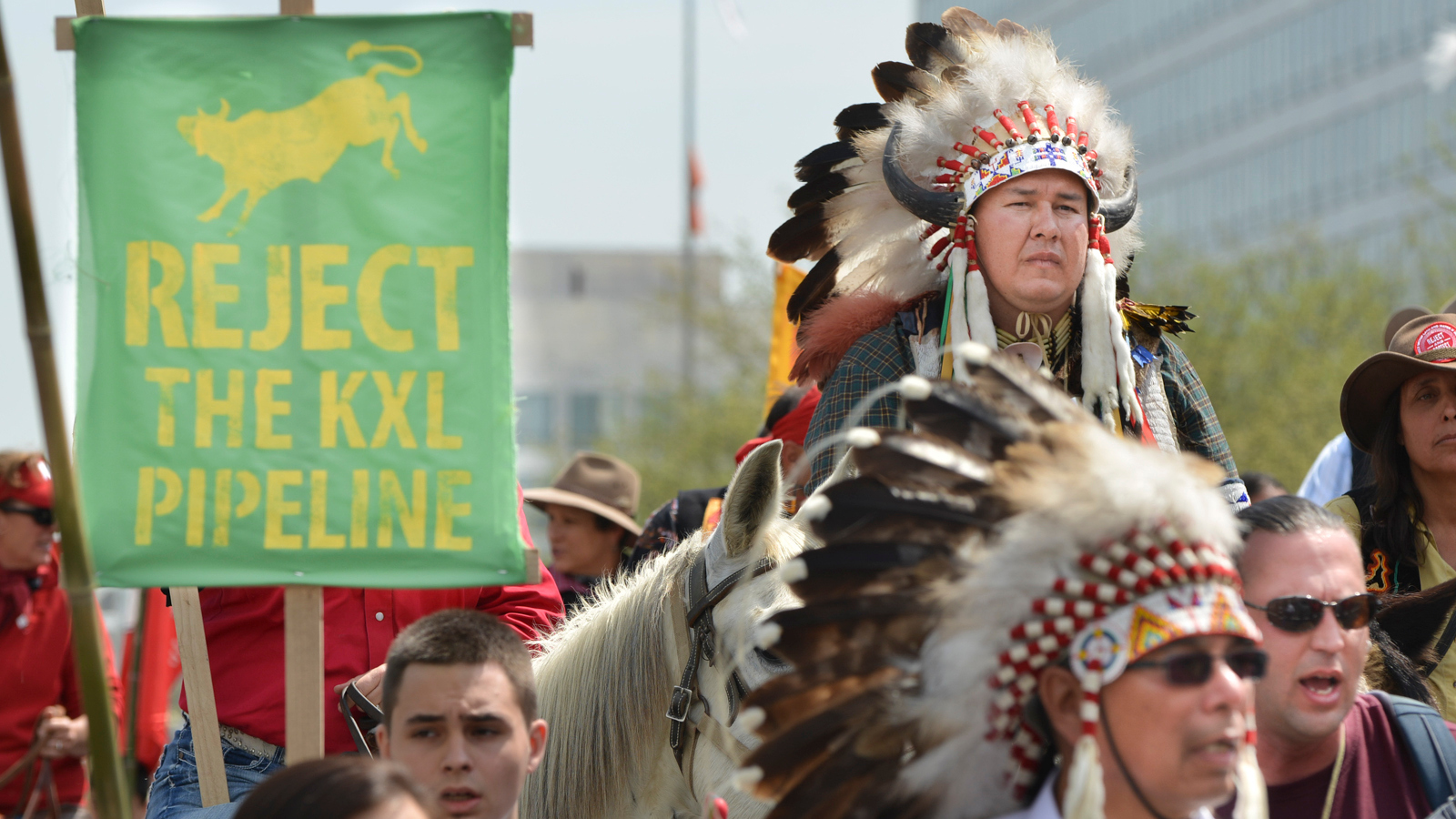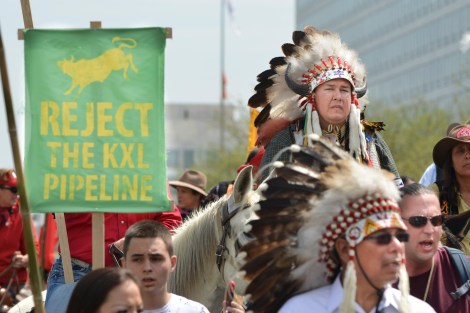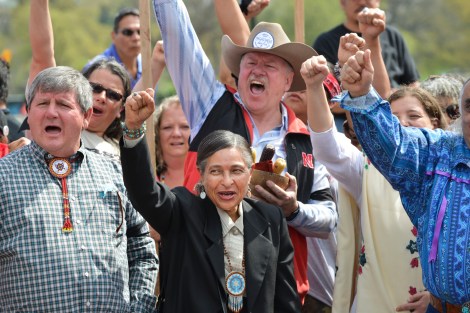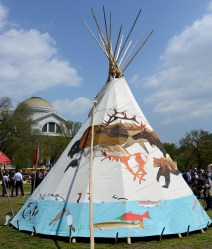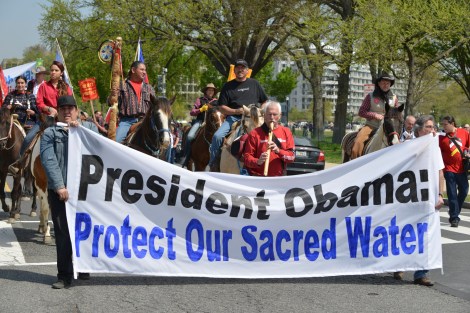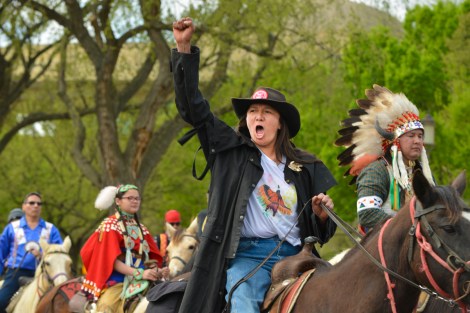WASHINGTON, D.C. — Visitors to the National Mall this week might have noticed an unusual addition to the monuments and Smithsonian museums: a collection of tipis. They were brought there by groups of Native Americans and Canadian First Nations, from as far away as British Columbia, and set up as an encampment to convince President Obama to reject the proposed Keystone XL pipeline. They were the central staging ground for a week of action, culminating in a march and rally on Saturday, by the Reject and Protect coalition. The theme of the week: “Cowboys and Indians.”
It may sound strange to name a progressive movement after a politically incorrect and outdated children’s game. But the metaphor is surprisingly apt. The coalition is an alliance between those famous historical adversaries: North America’s indigenous people and the ranchers and farmers with whom they share the Rocky Mountains and Great Plains.
Both groups are threatened by the Keystone proposal. Native Americans say that the State Department has failed to consult them about the risks of running the pipeline near their lands and holy places such as burial grounds. And in Canada, First Nations near the tar sands in Alberta oppose the exploitation of the area, citing local health and environmental hazards. Tar-sands drilling has led to cancer clusters and to contamination that affects locals’ ability to hunt and fish, says Clayton Thomas-Muller, a member of the Cree Nation from Alberta and a campaigner in Ottawa for Idle No More, an indigenous advocacy organization.
Ranchers, meanwhile, are having their land confiscated under eminent domain in order to get the pipeline built. The cowboys and Indians have come together, Thomas-Muller told Grist, because “rural landowners are being treated like Native Americans.” That is to say, their land is being stolen and despoiled.
Groups such as Bold Nebraska, which was one of the main event organizers, mobilized previously apolitical farmers and ranchers to come to Washington for the week, while Native American and First Nations advocacy groups like Idle No More brought their constituents, and national environmental organizations such as 350.org, the Sierra Club, and Public Citizen lent logistical support.
Indians inhabited the tipis during the week (but not overnight due to National Park Service rules), answering questions from curious passersby. They also painted a tipi as a gift for President Obama. On Saturday, they presented it to the National Museum of the American Indian.
The procession to the museum was led by ranchers on horseback and a group of Indians holding a wide banner reading, “President Obama: Protect Our Sacred Water.” Mekasi Horinek of the Ponca Nation in Oklahoma held up one end of the banner. He had driven 1,500 miles to D.C. and since Monday had spent all of his days at the encampment. The first leg of Keystone XL, from Oklahoma to the Gulf Coast, is already built near his home. If the rest of it is built, oil from the Albertan tar sands will course through it. “The Keystone pipeline will inevitably leak,” predicts Horinek. “Our land is going to be poisoned, and it will poison our drinking water.” Based on the historical and scientific evidence, experts believe that Horinek’s fears are warranted, and that the State Department underestimated the threat of leaks in its environmental impact statement on Keystone.
The rally was preceded and followed by rousing speeches, alternating with Indian prayers. Neil Young — jokingly introduced as “a young man, you might have heard of him, a musician” — made a speech as well. Tar-sands oil, he warned, “turns a Toyota Celica into a Chevy Suburban” because of the greater CO2 emissions involved in tar-sands extraction. Not one for understatement, Young declared, “I say to President Obama, this is your defining moment in the history of the world. … Why not stand up and put America on the right side of history?”
There were thousands in attendance. Although they included both cowboys and Indians, the majority appeared to be a more typical crowd for an environmental rally in Washington, D.C.: East Coast liberals with shaggy hair, beards, and sandals. But there was also a multiracial contingent of teenagers from Boston with social and environmental-justice action groups such as the Roxbury Environmental Empowerment Project.
Some groups led typical protest chants like, “Hey hey, ho ho, Keystone XL has got to go.” Meanwhile a group of Indians playing traditional drums provided a steady beat.
Throughout the day, speakers emphasized Native Americans’ tradition of respect for and unity with the land — in contrast with those who would pillage the land because they are “disconnected from their spirit,” in the words of Sun Dance Chief Reuben George of the Tsleil-Waututh Nation. The event was closed out with a rousing address by Gitz Crazy Boy, who is part Blackfoot and part Dene, and who works with children in Alberta. He said that stopping the pipeline is what the current generation owes to future generations, lest they be left with nothing but “a toxic cesspool.”
There was plenty of media in attendance, but President Obama was far from the scene. He’s currently in Malaysia as part of an Asian tour. This week’s protests were scheduled before the recent announcement that the State Department will again delay the Keystone decision. If the American government were to treat the indigenous population fairly in this decision, that might be a historical first. Obama, though, is supposed to be a historic, transformative figure. Many of the signs at the protest played on his iconic campaign images and slogans. His presence loomed as a friend who needs to be convinced, not an enemy to be defeated. But Obama is notoriously inscrutable, and the protesters were not all confident that they will win him over. They will carry on trying, though.

